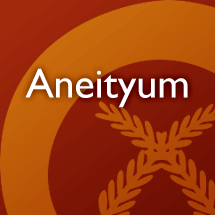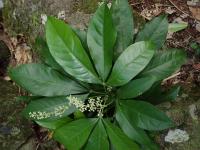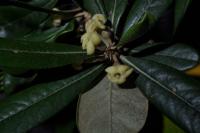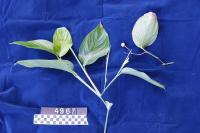Your search for * in kastom has returned 23 entries
inmadidi
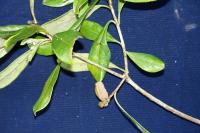
n. tree to 7 m, dbh 30 com (collection: Michael J. Balick #4870)
Example: This plant is used for spiritual purposes. When fruits are young, the children take the fruit, cut it open and take coconut leaf midribs, impaling the seeds on the midribs and painting themselves with the fruit.
bookmarkinmadidi
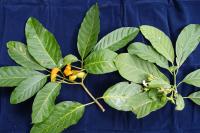
n. tree to 5 m, dbh 8 cm (collection: Michael J. Balick #4855)
Example: To treat a flu that has resulted in a thick, runny nose, collect sap of this tree, drink 2-3 drops directly (not in water). This is for treating the type of flu that provokes yellow mucus coming out of the nose. Drinking the sap breaks up the stuffy nose. Use once, it tastes very sour. In 3-4 days the mucus will be expelled. Do not use too much! If a person has a new cut, and the bleeding will not stop, place the sap on the cut and the bleeding will stop. If you have a burn that is bleeding, applying the sap will stop the blood and oozing sore. If a person has a sore on their body, cover it with a layer of the sap from this plant. This will ensure that the sore will not get larger from infection, flies, etc. but stay its original size. This plant is also used for unspecified spiritual practices. To determine if a fish you have caught is poisonous, e.g. with ciguatera, take an 8’ piece of small branch from this tree, peel the bark and put it inside the fish before you cook it on the earth oven. If the stick turns black, then you know that the fish is not good to eat--it has a poison so should be thrown away.
bookmarkinpa
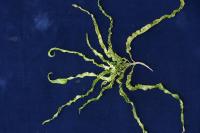
n. shrub, 1. 25 m tall (collection: Gregory M. Plunkett #3525)
Example: The young leaves are edible, after boiling for 5 minutes. A piece of coconut and a pinch of salt is wrapped in the leaves and eaten. The mature leaves are used to wrap food such as pig or cow meat and cooked in an earth oven. Tie this bundle with a piece of Pandanus fiber to secure it before putting in the earth oven. Both the green and ripe fruits are edible. This plant is used in kastom ceremonies. For a peace ceremony, if there is an argument, then this leaf is used to make peace between the parties. For many ceremonies, put on top of taro, kava or food pile, . For peace ceremony, when a person has food in an offering, give a branch of this plant to the other party to symbolize that the conflict is over. It is a "message plant" that conveys a meaning that people do not have to say out loud. When a stranger walks through a village with this plant in his or her hand, people know there is no threat or problem. When a young man first shaves, people give him a necklace of this plant. In the old days, hair was pulled out of young men, now people use razor blades.
bookmarkinpa
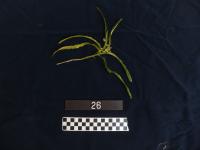
n. shrub. Growing in the village. Cultivated. (collection: Ashley A McGuigan #26)
Example: 1a. To stay healthy while pregnant - grate 1 coconut with nekei leaves, about a handfull (8). And 8 inpa leaves and 8 niditau leaves. Pound all of this together and squeeze juice out and bath in this then jump into a clear river to wash it off. 1b. Handful of leaves mashed with grated coconut and put in a shell, heat stones and put in shell, then take hot liquid to rub on body of woman who have just delivered to make their bodies healthy again, back to normal – when they deliver they are in huts, then wash with this and then come out of the huts and rejoin family. 2. Symbolic plant for peace (name means peace). 3. Message plant – put small tips of leaves in hair or make hat out of it and people know you come in peace. 4. When giving a gift, put this leaf on the gift, as in a basket – people wear them they are happy and peaceful – it is symbolic of Aneityumese people – so even when the people leave the island they will grow this plant. 5. People bathe with this leaf, mixed with grated coconut and cover body and hair to smell good and be strong. 6. Mosquito repellant, build fire, put green leaves on top, smoke and aroma chases mosquito away. 7. Take top of leaf with 3 young leaves and put in hair as there is the belief that this plant symbolizes the trinity. So it protects people. If a person from the island goes elsewhere and is faced with black magic they bathe with a handful of leaves, boil them and bathe with the liquid to remove the spell. 8. Decorate people with this leaf day feasts, weddings, and other events – very sacred.
bookmarkinrowod
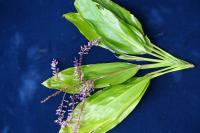
n. unbranched treelet, 1. 25 m tall (collection: Gregory M. Plunkett #3526)
Example: People use the leaves for cooking any ground up food that is cooked on a fire such as manioc or bananas, roasted or boiled in water. Fish can be cooked this way. The roots of this plant can be cooked in an earth oven. These need to be cooked for 2 days or 2 nights, lke a yam. The plant has large roots that are good to eat. Chew like a piece of surgarcane, the taste is sweet like honey. Swallow the juice and spit out the fiber. The roots, once cooked, can be stored for 6 months. In ancient times they were eaten during times when there was no food. This food is said to be able to sustain a person for one day, if eaten in the morning, the person not be hungry until sunset. Today, people eat this plant at festivals, as it is no longer a famine food.
bookmarkintekes ~ inrowod
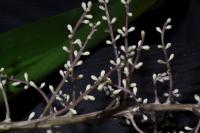
inteses
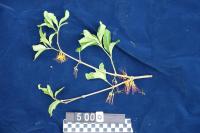
n. parasite in tree, flowers orange with reddish base. Growing in secondary forest. (collection: Michael J. Balick #5000)
Example: This plant is said to have a type of magical use. Young men take one node of the stem of this plant and use it in an unspecified way to attract young women.
bookmarkinteses
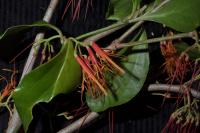
n. parasite on branches of Geissois denhamii tree, growing in dense rainforest. Flowers orange-red. (collection: Gregory M. Plunkett #4028)
Example: 1. This plant is known to kill other trees and is regarded as a parasite. 2. The plant is related to kastom use regarding the separation of two lovers--more information witheld.
bookmarknahas alaig imi yin
n. p. taro for the dead
bookmarknala
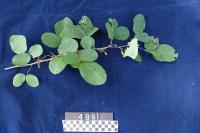
n. shrub to 2 m, coastal vegetation (collection: Michael J. Balick #4961)
Example: The stem of this plant is used for firewood. If a person has been drinking kava and the next morning feels hung over, they can take a handful of the leaves of this plant, crush them in cool water, and wash their face with this. This treatment will help the kava feeling to disappear.
bookmarknala
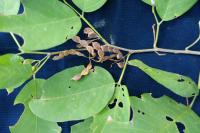
n. tree to 7 m, dbh 20 cm (collection: Michael J. Balick #4860)
Example: This is a common tree. If a person travels from one district to another on Aneityum, and you see the tree planted in that other district, a person knows they are free to come into this area. When the leaves are yellow, as in a young tree, the local name is nala’gay. If a person carries a branch of this tree into a village it is a symbol that the person is coming with peaceful intentions.
bookmarknala
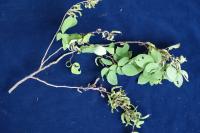
nala
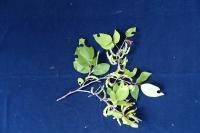
nala
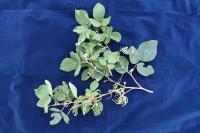
n. shrub, 1. 5 m tall (collection: Gregory M. Plunkett #3217)
Example: 1a. When traveling past a community you can place these leaves in a basket or walk with it in your hand. In this way people in the community know that you are traveling in peace and will cause no harm to people in that village. 1b. Message plant – if you go to visit someone and they are not there, you leave a branch of this on the door or somewhere they can see it and they know that some relatives have come and tried to visit them.
bookmarknauhap̃
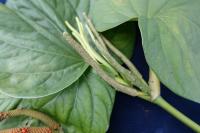
n. small tree or shrub, 2 m tall (collection: Gregory M. Plunkett #3210)
Example: 1. Use the leaves to put in a hole where taro is being planted, as a sort of fertilizer--it rots easily and adds value to the soil. To protect a person from spirits if you are going to an unfamiliar place, take the young inflorescence and put behind your ear. This plant is a sort of "spiritual kava." 2. Flowers are put behind one ear, any side, to allow a person to pass through sacred places. For protection of the spirits especially if you are familiar with this place. On EAST SIDE, put one leaf under pillow before sleeping so that the lady spirit will not disturb the person. Only for men – spirit likes men, and wants to have sleep with them. If she gets pregnant, you must follow her to look after the kids in the spirit world so you leave this one (you die). 3. The small, straight stems of this plant are used as rafters to weave thatch. 4. Children make bows and arrows from the stems as well as spears for fishing.
bookmarknauhap̃ apeñ
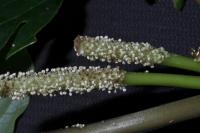
naupitju
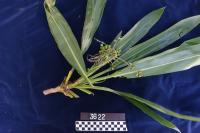
n. treelet, 1 m tall (collection: Gregory M. Plunkett #3622)
Example: People use the leaf of this plant to tie over grated banana, taro or other foods for cooking in an earth oven or boiling in a pot. The root of this species is edible. Cook it for 2-3 nights in an earth oven and then chew and squeeze the juice into your mouth, spitting out the fiber. It is a survival food.
bookmarknelas
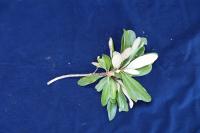
noposeri
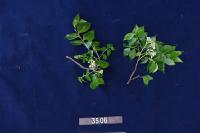
n. tree, 3 m tall (collection: Gregory M. Plunkett #3506)
Example: 1. The leaves of this plant are used in a kastom ceremony; crush the leaves and put in a head garland or on an arm band to release a pleasant odor during a kastom dance. The name of the plant is stated in a kastom song. 2. The leaf is a component for making "love magic." Crush these leaves as well as other unspecified leaves in a person’s hand while stating the name of the person you wish to fall in love with you, and it is said that they will. 3. Message plant – There are special people who compose traditional song about the person or legends, history, so the person who wants the song gives the composer this plant with other unspecified plants and the composer will have a dream that night and spirits will give song and melody and compose a song. Song is for Kastom ceremony singing while dancing.
bookmarknouhap̃
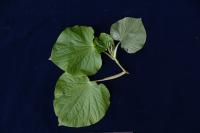
n. shrub, 2. 5 m tall (collection: Gregory M. Plunkett #3511)
Example: 1. Use the leaves to put in a hole where taro is being planted, as a sort of fertilizer--it rots easily and adds value to the soil. To protect a person from spirits if you are going to an unfamiliar place, take the young inflorescence and put behind your ear. This plant is a sort of "spiritual kava." 2. Flowers are put behind one ear, any side, to allow a person to pass through sacred places. For protection of the spirits especially if you are familiar with this place. On EAST SIDE, put one leaf under pillow before sleeping so that the lady spirit will not disturb the person. Only for men – spirit likes men, and wants to have sleep with them. If she gets pregnant, you must follow her to look after the kids in the spirit world so you leave this one (you die). 3. The small, straight stems of this plant are used as rafters to weave thatch. 4. Children make bows and arrows from the stems as well as spears for fishing.
bookmark